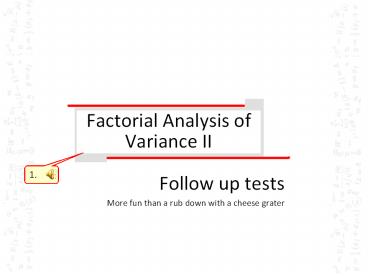Factorial Analysis of Variance II - PowerPoint PPT Presentation
1 / 16
Title:
Factorial Analysis of Variance II
Description:
For main effects, request follow ups for IV s with 2 levels. KNR 445. FACTORIAL. ANOVA II. Slide . Follow-ups for Main Effects. 2. 1. Post Hoc lets you ... – PowerPoint PPT presentation
Number of Views:124
Avg rating:3.0/5.0
Title: Factorial Analysis of Variance II
1
Factorial Analysis of Variance II
1.
- Follow up tests
- More fun than a rub down with a cheese grater
2
Follow-ups for Factorial ANOVA
- Recall possible outcomes from Factorial ANOVA
- Main effects
- Interactions
- What might be missing (not specified) from these
results? - Differences between pairs of means within each
factor (if levels of factor are gt 2) - Differences between cells giving rise to
interactions
1.
2.
3
Follow-ups for Main Effects
- For main effects, request follow ups for IVs
with gt 2 levels
1. Post Hoc lets you request follow-ups, but
only to the main effects
2.
4
Follow-ups for Main Effects
To do a post hoc on the main effects 1. select
the variables
2. Slide them over
3. Select the post hoc test
4. Continue
5
Follow-ups for Interactions
- What is an interaction?
- Arises from the cell means/SDs
- Significant non-parallelism
1.
2.
4.
Pressure Level Pressure Level Pressure Level
Low Pressure Moderate pressure High Pressure
Anxiety Level Low Anxiety M 5 (3, 7) M 8 (7, 9) M 11 (10, 12) MA1 8
Anxiety Level High Anxiety M 4 (3, 5) M 6 (5, 7) M 2 (2, 2) MA2 4
MB1 4.5 MB2 7 MB3 6.5 Mtotal 12
3.
6
Follow-ups for Interactions
- Subsequent simpler analyses
- These can go in at least a couple of directions
- With a 3 x 2 ANOVA, you could do
- 2 one-way ANOVAs (one at each level of the IV w/2
levels) - One 1-way ANOVA on low anxiety
- One 1-way ANOVA on high
1.
2.
In our example, this would be looking for
differences in performance associated with
pressure level, within each anxiety level
Pressure Level Pressure Level Pressure Level
Low Pressure Moderate pressure High Pressure
Anxiety Level Low Anxiety M 5 (3, 7) M 8 (7, 9) M 11 (10, 12)
Anxiety Level High Anxiety M 4 (3, 5) M 6 (5, 7) M 2 (2, 2)
3.
5.
4.
7
Follow-ups for Interactions
2.
1.
3.
8
Follow-ups for Interactions
1.
2.
9
Follow-ups for Interactions
- Subsequent simpler analyses
- Second possibility
- 3 t-tests (one at each level of the IV w/3
levels) - In our example, this would be looking for
differences in performance associated with
anxiety level, within each pressure level - One for low pressure
- One for moderate pressure
- One for high pressure
1.
2.
10
Follow-ups for Interactions
1.
11
Follow-ups for Interactions
1.
12
Follow-ups for Interactions
- Final step control for type 1 error
- Because you are now conducting multiple tests,
you should adjust your significance threshold to
control for type 1 error. - The Bonferroni adjustment is suitable here
- divide ? by the number of tests being run
- So for 2 1-way ANOVAs, use ? .05/2 .025
- For 3 independent t-tests, use ? .05/3 .017
1.
13
Follow-ups for Interactions
- Follow-ups on significant interactions
- Bear in mind that any test conducted after the
initial interaction is less powerful than the
initial test - So sometimes you will get no significance from
the follow-up despite a significant initial test - In this instance, all you can do is suggest
cautiously where the differences lie, by
inspection
1.
14
Follow-ups for Interactions
- Follow-ups on significant interactions
- Note on ordinal (uncrossed) and disordinal
(crossed) interactions - Regardless of whether the interaction crosses or
not, there is a good chance that main effects
found in these analyses are not genuine (that is
their existence depends on the level of the other
factor) - Always interpret a main effect with caution if
there is a significant interaction involving that
main effect
1.
2. Uncrossed genuine main effect
3. Uncrossed no genuine main effect
4. Crossed no genuine main effect
15
Follow-ups for Factorial ANOVA
- Summary
- No significant effects -No follow ups
- Significant main effect only
- Pairwise comparisons within significant effects
- Significant main effects and a significant
interaction - Caution in interpreting main effects (examine
graph of interaction)may be superseded by
interaction - Try to find the locus of the interaction (by
further ANOVAs and t-tests with Bonferroni
adjustment) - Significant interaction only
1.
16
(Partial) Flow chart for Factorial ANOVA
yes
Adjust DV and try again
no
Run ANOVA
Is homogeneity significant?
1
Are there any significant effects?
Stop!
no
yes
What are they?
Only interaction
Only main effects
main effect(s) and interaction
Use post-hocs to interpret like t-tests
1. Use post-hocs to interpret main effects, BUT
consider plot of interaction to see if genuine.
3. Use adjusted a to interpret significance
2. Split file by one variable and run either
t-tests or 1-way ANOVA on other to examine locus
of interaction
- Include homogeneity tests descriptives partial
?2 request post-hocs if appropriate, and PLOT of
interaction.
Done.

